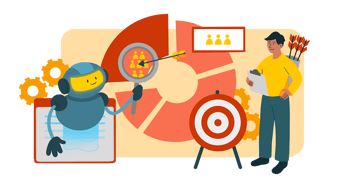A Business Guide to Market Segmentation - Startup Edition
As your startup's CEO and chief bottle washer, you've undoubtedly spent a fair bit of time compiling your ideal buyer persona. There's so much to know about who you're targeting your widget at, demographics, psychographics, geographics, et al., right? And once you have all of that data sorted, sifted, and parsed, the last thing you want to do is more sorting, sifting, and parsing.
But what if we told you that by conducting one more round of research and creating separate segments of your ideal audience, you could see better ROI on your marketing spend, pull in more sales faster, and even build your brand within months of launch?
Market Segmentation: The Basics
A proper market segmentation strategy can do more for your business. It's the practice of carving your target audience into smaller niche markets based on individual categories or parameters. Have you defined your ICPs and buyer personas? For example: say your first product is an app encouraging people to save a certain percentage of their net income. You've done initial market research and determined that Gen-Z is your ideal audience, so you're tailoring your campaigns for mobile-friendliness, developing a robust social media presence on all the right channels, etc.
Here's the thing, by saying "Gen-Z" is your target, you're only narrowing your target from the entire population down to its largest single cohort. So from many millions to several million. Not as helpful when you look at it like that, huh? What if you could go further and narrow it to a segment of less than one million? Keep researching, and maybe you'll find that Gen-Zers who recently moved to a big city are a solid niche to target.
These folks likely made that move for a good job, right? So not only are they more likely to have income that supports the idea of saving since they're not necessarily working paycheck to paycheck, but they're also undergoing other life changes and the idea of adding one more little one like your app will feel appropriate. Using geographic data alongside your original demographic research, you can focus your initial marketing push on these recent relocators and stand a much better chance of landing sales.
Market Segmentation for Startups: The Why
The amount of work needed to segment an audience by parameters you already have in place is minimal, yet the potential rewards are enormous. You've already put in the time and energy to develop your persona based on the above demographic, psychographic, and geographic factors. All that’s required now is to divide that total audience into smaller slices based on one particular factor to better target content and messaging starting pre-launch.
It’s easier and cheaper to target smaller segments of a population. Think about Facebook ads. If your target is 2 million people and your ad is being served 1 million times daily, that's expensive. Imagine that your segment is 1 million people, and your more precisely worded ad is served 350,000 times daily. That's way cheaper and is being seen by a more appropriate audience.
That narrower targeting means more wins earlier in your campaign, which does wonders for cementing your reputation with your early adopters. These folks are likelier to become evangelists, touting your app to all their friends and coworkers. By focusing your efforts on a smaller niche segment of your audience, you reap the rewards often reserved for the biggest players in their industry: a solid reputation, brand ambassadors, and word-of-mouth marketing.
Key Benefits of Market Segmentation
-
Improved targeting: Segmentation allows companies to tailor their marketing efforts to specific groups with similar needs and preferences.
-
Increased efficiency: By focusing on specific segments, companies can reduce their marketing spending and increase the effectiveness of their campaigns.
-
A better understanding of customer needs: Market segmentation helps companies understand different groups' specific needs and wants, allowing them to tailor their products and services accordingly.
-
Increased customer satisfaction: Companies can improve customer satisfaction and loyalty by providing targeted offerings.
-
Improved product development: Segmentation allows companies to identify opportunities for product development that specifically target unmet customer needs.
-
Enhanced competitiveness: Companies can gain a competitive advantage by understanding and serving specific segments better than competitors.
-
Increased profitability: Companies can increase their overall profitability by targeting the most profitable segments and reducing marketing spending on less profitable segments.
-
Better allocation of resources: Segmentation helps companies allocate resources more efficiently, allowing them to focus on the segments with the highest growth potential.
-
Improved customer loyalty: By providing a personalized experience, companies can increase customer loyalty and reduce churn.
-
Enhanced brand image: By delivering tailored marketing messages, companies can improve their brand image and reputation among target segments.
With the advancements of AI, Customer Segmentation will no longer be optional or "too hard to do."
Segmented Marketing: The How-To
Assuming you've already done at least an initial round of market research to develop your buyer persona, the first step is to dig deeper into the same factors. Start with Google Analytics and similar platforms that can uncover your audience's browsing habits. You're looking for demographic info like age, gender, education level, etc. This basic info will form the backbone for your next round of digging, where the niche segments will start to clarify themselves.
Next, start sifting your audience into segments. To follow up on our earlier example, you're looking for a segment of Generation Z who can spend a little on your app to kickstart their future savings. A recent geographic move for a great job would be ideal for segmenting these folks.
And finally, look for a way to segment one more time, say by current income level. Just because someone got an advanced degree from a great school doesn't mean they've found their dream job. Underemployment is rampant among this generation, so you'll want to be careful who you target with an app for saving. People working paycheck to paycheck aren't going to take kindly to messaging in their Facebook feed about how important saving money is when they're not sure they can make rent that month.
Customized Marketing
Now that your overall market is divided into smaller niche segments, you can customize your messaging, content, and channel presence specifically to each segment. Early wins are key to creating happy customers who will willingly become your first brand ambassadors, working on the ground to help you spread the word about your app. By targeting only the segments of your initial audience most likely to convert quickly, you save yourself the time, energy, and, importantly, the budget of trying to reach a wider audience.
Segmentation means you can word your messaging to resonate with that niche. It means you can spend less on first-round advertising and put more resources into development. It also means you can target several of these smaller niches at once, a sort of A/B test of your market, to see which group responds the best. And with the money you've saved, you'll be ready and able to rework your campaign content based on the results. From there, it's a simple matter of iterating your marketing content and expanding your segments gradually as sales increase until you reach your ideal market with the content they want.










Leave a Comment